Scientists Attempting to Bring Back to Life This Enormous Extinct Cow, Mammoths are Next
The age of de-extinction is among us! Some of Europe’s top Scientists are close to bringing back to life a huge ancient cattle species called an Aurochs.
Aurochs were kings of Europe and had free roam of the land for thousands of years until the last of their kind died in the Jaktorow Forest in Poland in 1627.
Aurochs are huge beasts, experts say they were 7 ft (2.13 m) tall and weighed around 1,000kg.
Since 2009, European science teams have been breeding cattle which still carry aurochs DNA. Two programmes are attempting to revive a version of the aurochs through breeding.
Widget not in any sidebars
One is Operation Taurus, which has selectively bred 300 calves with aurochs DNA via a process called back-breeding.
They select breeds of cattle which have certain aurochs characteristics and each generation of calves gets closer to the original aurochs in appearance, behaviour and genetic makeup.
There are several breeds of cattle the scientists use which have characteristics closest to the aurochs, including the Maremmana from Italy and Podolica and Busha breed from the Balkans.
Professor Donato Matassino from the operation told The Telegraph:
They have the highest percentage of aurochs genetic material. I don’t think we’ll ever beable to create an animal that is 100 percent like the aurochs, but we can get very close.
The Taurus Project in Portugal Another is another programme trying to revive the aurochs and has also been cross-breeding species in an attempt to bring the extinct animals back to life.
These programmes are all part of the Rewilding Europe project. It’s an initiative that aims to reintroduce Europe’s lost, wild species, which would not only help the environment, but also be good for local tourism.
Wouter Helmer, founder of Rewilding Europe, told The Telegraph:
Wild cattle are one of the species that shaped the European landscape over hundreds of thousands of years. If there are no large herbivores then the forest regenerates very fast. Big grazing animals keep patches of land open and create variety in the landscape which helps many thousands of species of plants, insects and animals.
Cave paintings across Europe have also been shown to depict Aurochs, suggesting thay they were an important part of our agriculture, another reason scientists want to bring them back.
Recently added to the list for “de-extinction” are woolly mammoths and moas which were giant flightless birds.
What are your thoughts on the issue? Are the experiments crossing too many ethical boundaries and should they be allowed to continue, or is this good for mankind in the long run with the reintroduction of extinct species?




